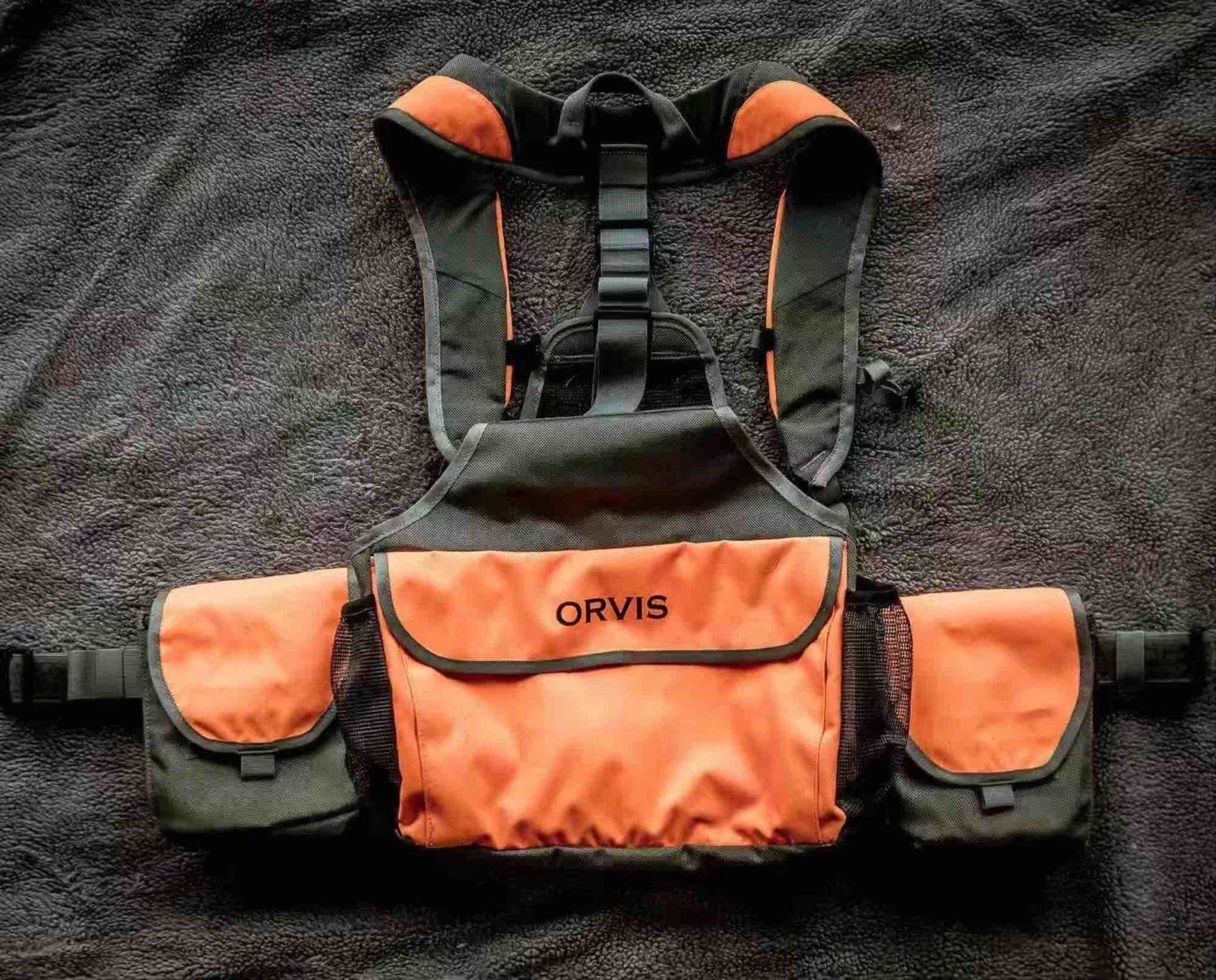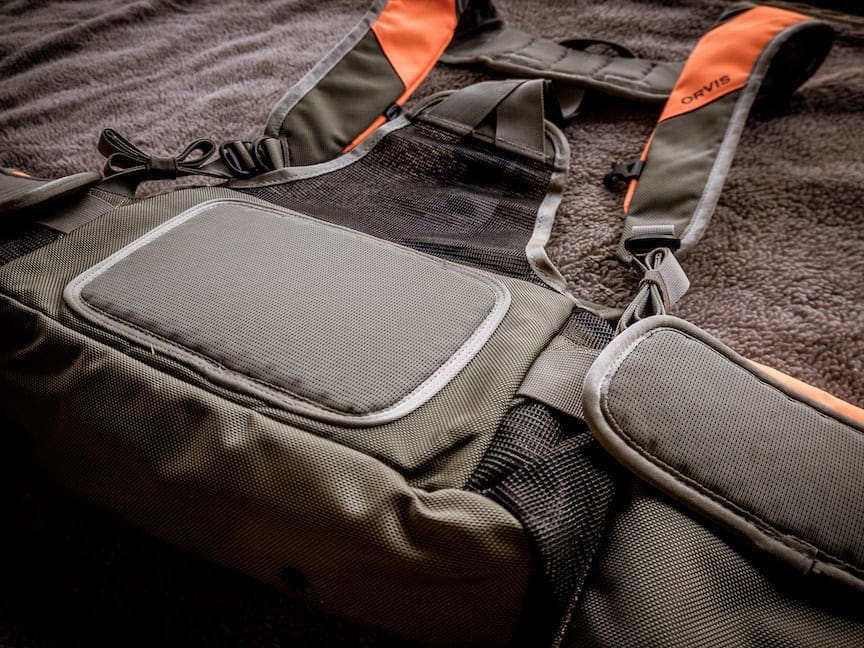Home » Hunting Gear » Gear Review: Orvis Pro LT Hunting Vest
Gear Review: Orvis Pro LT Hunting Vest

Ian Burrow discovered his affection for hunting as an adult.…
In an era of upland hunting vest innovation, this classic remains a great choice for hunters looking for an economical and functional strap vest
The upland community has seen a surge in vest innovations in recent years. The primary innovation seems to be the ability for the end user to configure and customize the vest’s layout through a variety of pouches and accessories. That concept certainly has its merits, but for those looking for that capability, the Orvis Pro LT hunting vest isn’t for you. However, those looking for a vest that meets the sweet spot between a minimalist strap vest and the more elaborate setup of endless pouches, accessories, and configurations, this may be your leading contender.
The adjustable ammo pouches, waist belt, yoke, and chest strap should yield a comfortable fit for just about anyone. The distribution of the vest’s load across one’s hips, along with the lower back support, mitigate the back and shoulder aches often associated with a long day hauling around birds and shells. Finally, with an MSRP of $169, this vest is priced competitively for the features, comfort, and durability it brings to the field.
SUBSCRIBE to the AUDIO VERSION for FREE : Google | Apple | Spotify
Pros of the Orvis Pro LT Vest
Weight Distribution
The Pro LT vest’s ability to evenly distribute weight, and thereby mitigating muscle fatigue, is hands-down the vest’s greatest selling point. I’ve put a lot of stuff on my shoulders over the years. From Army rucksacks in the desert to backcountry meat-hauling backpacks in the mountains, I’ve learned the hard lessons associated with proper fit and weight distribution of gear worn and hauled. This vest’s lower back and waist padding compares to that of a high-caliber backcountry pack. Its sturdy padding, employed in conjunction with the various adjustment points across the vest (chest, shoulders, yoke, belt, ammo pouches), allows the wearer to disseminate the bulk of the load to the hips and away from the shoulders.

In just a few minutes out of the box, I was able to make the various adjustments I knew to be the right fit for me. One of the more prominent of these adjustments was transitioning the ammo pouches from the anterior of my body, where many vests relegate their ammunition storage, to the sides of my hips. This allowed for a greater range of motion in my legs and prevented boxes of shot shell from bouncing on my thighs or abdomen. I also found this to be a more natural placement for my hand to fall and draw shells. Next, I cinched down the waist belt, yoke, and shoulder straps until the vest fit snugly around my body, resting just above the belt line of my trousers.
Carrying Capacity
I would probably bring a kitchen sink with me on every hunt if it was feasible. That’s just the kind of hunter I am. I’m always thinking, “I might need this…” and before I know it, my truck and bags are filled to the brim. Something I really appreciate about this vest is how it politely tells me to stop packing and just go hunting. Prior to using this vest, I hunted with the LL Bean Technical Upland Vest Pack. The multitude of zippered compartments in the back of the vest were just begging to be utilized. Unfortunately, that just resulted in me walking miles on end with a bunch of stuff strapped to my back that I really didn’t need.
If you can’t fit it in the two ammo pouches, two water bottle holders, one large compartment, and two zippered security pockets, then you won’t be carrying it with the Orvis Pro LT Hunting Vest. The large compartment is big enough for a collapsible dog bowl, small canine first aid kit, a protein bar, and an oiled rag while the zippered compartments are big enough for your wallet and keys. This vest seems to hit the middle ground in vest carrying capacity. I can comfortably tote a few essentials, like that canine first aid kit, whereas some of the traditional strap vests offer very little extra storage space beyond birds and ammo. Conversely, I have to be somewhat selective in what I elect to carry with me, unlike in larger, modern vests that can haul enough gear for a camping trip.
Construction and Durability
Orvis has delivered another well-made, durable piece of gear. The 1680D Nylon fabric, along with the vest’s strong seams, can tackle the nastiest of plum thickets despite how lightweight the fabric is. It’s apparent that the team at Orvis took careful consideration with their textile selection and application. The padding material, as well as the back of the “bird compartment,” are a breathable mesh. Unlike some other vests, the Pro LT doesn’t leave the back of your shirt soaked in sweat or your hips rubbed raw. I have no doubt this vest will live to see my grandchildren chase birds.
Cons of the Orvis Pro LT Vest
Water Accessibility
I carry two 32oz Nalgene wide-mouth bottles when upland hunting. These bottles are pretty wide and sometimes it can be difficult to find a piece of gear, or a vehicle’s cup holder, that can accept something so wide. The mesh bottle holders of this vest are so tight that I struggle to return my bottles to their resting place in between water breaks. What adds to that struggle is the placement of the holders. Sitting nearly at my kidneys, I found myself setting my shotgun down and reaching back with both hands to wiggle a bottle out of the iron grip of the coated mesh material.
The placement, from a weight distribution standpoint as well as for the sake of hip flexor comfort, makes sense. By holding the water (in my case, that’s 64oz or 4lbs) further back on the vest, the bottles won’t knock on your thighs as you high step across the plains. This also makes the vest more manageable when jumping in and out of a vehicle. That leaves me caught between a rock and a hard place. Vest designs force me to choose between effortlessly accessing my water while being able to quickly return the bottles to their pouches or being able to evenly distribute the weight of the hydration sources while leaving my hips and legs unencumbered to traverse the uplands.
It’s possible that if I used the taller, skinnier bottles that some of my friends use, I would have an easier time accessing my water. I also have to look at the overall necessity of functionality for this vest. It’s more important to me to be able to walk smoothly through the uplands than it is for me to drink water at a faster rate.
Quick Reloads
The two ammo pouches can each hold two boxes of loose 12 gauge shells or accommodate one box of shells, still in the box, with room to spare. They can also be adjusted across the waist belt to meet the shooter’s preferences. These are all good things, but my critique here is the flap closures of the pouches. The hook-and-loop is certainly secure, but the flaps can feel a bit clumsy at times if you’re trying to quickly reload. If you aren’t worried about losing shells, you could tuck the flap into the pouch itself, which would leave you with an open mouth pouch to empower your reload speed.
This is by no means a deal breaker for me. After all, no matter how fast I reload, I doubt I’ll ever reload faster than the speed of a pheasant soaring away from my first couple shots. If there was ever a 2.0 version of this vest, I’d advocate for a return to its predecessor’s approach to ammunition pouches. The ammunition pouches on the Orvis Pro Series Hunting Vest, this vest’s predecessor, have a snap closure, along with internal quick-access shell loops, while maintaining the same overall shell capacity.
Final Thoughts on the Orvis Pro LT Hunting Vest
This vest is extremely comfortable which makes it perfect for long treks through the uplands. Some users may be disappointed in the lack of modularity and end-user configuration as seen in some other modern vests.
Ian Burrow discovered his affection for hunting as an adult. Although he is still a novice of the passion in many respects, he strives to mentor new hunters as often as possible, knowing firsthand just how daunting it can be to take up hunting for the first time. Ian is a U.S. Army veteran and currently works for a software company that builds the technology that state agencies use to sell and manage their hunting and fishing licenses. He is married to his beautiful wife, Alexis, and they currently reside in North East Kansas.




I got one of these for grouse hunting but am concerned about the shallow game pouch. It seems to me that birds could fall out or resuscitate if not “dead enough” when placed in the pouch. Anybody have experience with this?